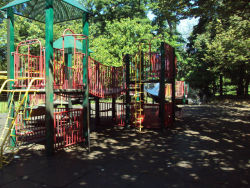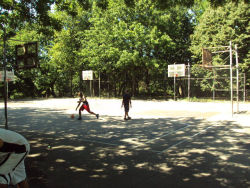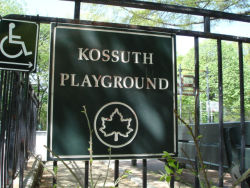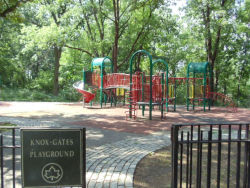Mosholu Parkway
Kossuth Playground
What was here before?
Mosholu is an Algonquin term meaning “smooth stones” or “small stones” and refers to the nearby creek now known as Tibbett’s Brook. The southern end of Moshulu Parkway was once home to another creek that ran under what present-day Middlebrook Road, which supplied water to a British fort located on old Van Cortlandt Avenue East during the Revolutionary War. This neighborhood of Norwood, also known as Bainbridge, was part of Westchester County until 1873 when this area was annexed to New York City.
How did this site become a playground?
A widespread park and parkway movement in the 1860s, led by distinguished landscape architect Frederick Law Olmsted (1822–1903), conceived a system of parks connected by landscaped scenic roads called parkways. In 1881, John Mullaly (1835–1915), a former newspaper reporter and editor, and a group of citizens concerned with widespread urban growth formed the New York Park Association. The group’s lobbying efforts helped pass the New Parks Act in 1884, which funded the acquisition of several major undeveloped properties with the purpose of creating parks and parkways. By 1888, the City had acquired properties in the Bronx such as Van Cortlandt, Pelham Bay, Bronx, Crotona, and Claremont Parks, as well as four parkways, including the Mosholu Parkway. This 600-foot-wide, landscaped highway connects Van Cortlandt Park to the northwest with Bronx Park to the southeast.
With the population in the Bronx growing, and a need for more recreational space, Kossuth Playground opened on September 6, 1930 and featured a recreation building, basketball court, volleyball court, shuffleboard court, and climbing equipment. In 2020, the playground was renovated to include new play equipment, spray shower features, basketball courts, fencing, and plantings.
Who is this playground named for?
This playground named after the adjacent avenue, Kossuth Avenue, for Lajos Kossuth (1802–1894), a leader in the Hungarian radical reform movement of the 1830s. Kossuth was born to a family of noble heritage in Monok in northeastern Hungary. Trained as a lawyer, Kossuth edited several journals and newspapers that allowed him to broadcast his increasingly popular ideas. He issued fiery pleas for Hungary’s independence from Vienna’s Hapsburg Monarchy, for the emancipation of the peasants, and for industrial development. Kossuth was elected to the Hungarian Diet (national assembly) in 1847, and a year later he led the revolution that created a new national government for Hungary.
When the new government fell to Russian and Austrian armies in 1848, Kossuth fled into exile. Sympathizers in the United States identified with the aims of overthrowing the foreign monarchy and establishing republican government for Hungary. When Kossuth visited New York in December 1851, he was given a tremendous welcome, described in the New York Times as one of “the most magnificent and enthusiastic ever extended to any man in any part of the world.” A reception hosted by Mayor Ambrose C. Kingsland, banquets, and a parade up Fifth Avenue were held in his honor. Kossuth lived in exile in England and in Italy. After his death in Turin in March 1894, his body was brought to Budapest and buried in state. A monument to Kossuth designed by Hungarian sculptor Janos Horvai (1873–1944) stands at Riverside Drive and 113th Street in Manhattan and Hungarian Independence Day (March 15) is celebrated in front of the monument.
Check out your park's Vital Signs
Clean & Safe
Green & Resilient
Empowered & Engaged Users
Share your feedback or learn more about how this park is part of a
Vital Park System




